Edwin S. Votey
built the first piano-player
(often called a "console" or "push-up" in our time),
the year being 1895. He was already involved with pipe and reed
organ manufacture – and creative marketing – before embarking on
this type of mechanism. The Pianola was not the first
piano-player but its success was unheralded through elaborate
magazine advertising and demonstration concerts in the States
and abroad.
The piano-player was used in connection with
a grand or upright piano, rolled up to the keyboard and played
the instrument through felt-tipped 'fingers' (of wood and later metal).
The roll in front operated a span of 58 notes, which used the existing scale for
player reed organs and some pipe organs built at that
time. The inside of the Pianola was not unlike that of the later
Player-Piano (ie. a player action built into an enlarged piano
case), featuring ducts, tubes, valves and all the components of
the familiar pneumatic actions.
How many of this first model were built,
before production took place in Detroit MI, is not known to this
writer. The traditional Pianola
which was mass produced beginning in 1898 had a lower, sleeker
appearance, not dominating the front of the piano to which it
is attached. Mr. Votey is seen at the right in this
picture, donating his original model to The Smithsonian
Institution in 1922. That same Pianola - hidden among the pianos and other
instruments in their basement location - was still
there in 1961 when we
visited ... repairing their antique musical boxes at that time.
The exterior of this device, which launched a worldwide
industry, was pristine ... so if still there, this piano-player
could be brought to life again, should a skilled repairman be
engaged to tackle the job.
The 58 note range of the multi-purpose rolls
(for organ and piano) was a limiting factor. I touched upon this
in my page about player roll developments. Read the first three
paragraphs called THE EARLY YEARS here http://wiscasset.net/artcraft/studio.htm
In spite of this "organ keyboard" spectrum,
the Aeolian Co., now with Votey in charge of many operations,
advertised "hand played rolls" would be available in 1899,
through displays in The
Century and other magazines of the day. Such rolls never appeared.
A few demonstrations of the 58 note Pianola along with a record/playback setup using vibrating punch pneumatics
did not please the critics of the day; the negative reviews
still exist for those who wish to read them. By 1900, Aeolian
had expanded the range to 65-notes and the rolls were being
developed and annotated for pianos only. The focus now
changed to the roll interpreter's tasks and various improvements
such as the Metrostyle line (for tempo variation suggestions)
and the Themodist (a solo accenting system) began to appear. By
1909 the modern 88-Note roll was standardized. Aeolian in the
meanwhile had purchased the Weber Piano Co. (makers also of the
Stuyvesant and Wheelock pianos) as well as the Geo. Steck Co.
These instruments, beginning in 1903, were called Pianola Pianos in their
advertising. They would be considered Player-Pianos by most
people today, along with many other brands in the field.
Until Player-Pianos pushed the Pianola aside
as the popular instrument, this piano-player sold many uprights
and grands, from Kohler & Chase to Hardman & Peck and
just about any other manufacturer active in those days. The promotional partnership
ended with the debut of the Geo. Steck and Weber
Pianola Pianos (in the 65-Note scale).
If this first model of the
Pianola still exists in the Wash. DC museum, I hope it can be
rebuilt and performed for the public in the near future.
 Here's another view of that "only surviving" 1895 Pianola
by Votey, taller and bulkier than the models mass produced,
beginning in 1898
Here's another view of that "only surviving" 1895 Pianola
by Votey, taller and bulkier than the models mass produced,
beginning in 1898
-- L.
Douglas Henderson
ARTCRAFT Music Rolls
Wiscasset, Maine 04578
Novemer 10, 2011


